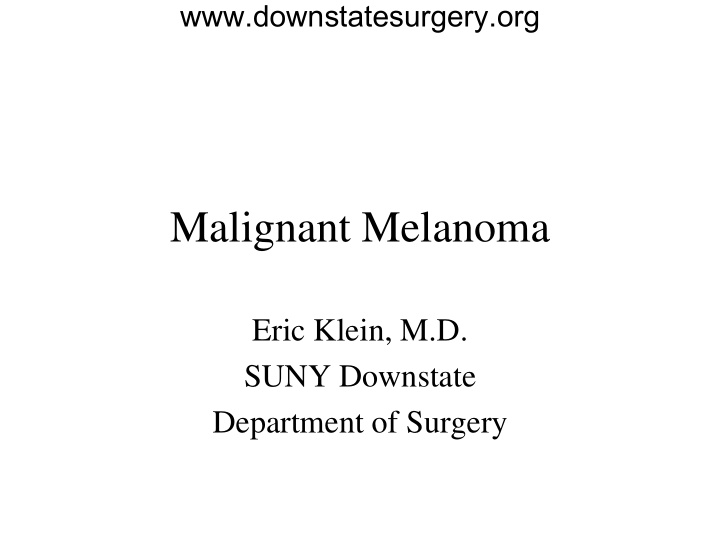



www.downstatesurgery.org Malignant Melanoma Eric Klein, M.D. SUNY Downstate Department of Surgery
www.downstatesurgery.org Case Presentation
www.downstatesurgery.org HPI • 62 y/o male Vietnam veteran • PMH – HTN, hyperlipidemia, PTSD, depression
www.downstatesurgery.org Dermatology History • 9/27/2007 - s/p 8mm x 7mm x 1mm shave biopsy of right arm lesion – 7mm round pearly brown-red papule – suspected BCC vs. seborrheic keratosis – Path: 0.7mm malignant melanoma • 10/18/2007 - s/p 10mm x 10mm wide local excision of right arm wound down to fascia – Path: malignant melanoma
www.downstatesurgery.org
www.downstatesurgery.org
www.downstatesurgery.org Follow-up • Serial full-body skin exams every 6 months • 12/14/2010 – noted to have 1cm mobile non-tender lymph node in right axilla • 12/22/2010 – PET/CT – 15mm x 8mm right axillary lymph node – SUV 5.3
www.downstatesurgery.org Surgery • 1/19/2011 – excision of right axillary lymph node, right axillary lymph node disection – Frozen path: 15 x 10mm black mass, metastatic malignant melanoma confined to lymph node – Permanent path: 9/9 lymph nodes negative – Immunohistochemistry: • S100+ • HMB45+ • WT-1+
www.downstatesurgery.org Discussion
www.downstatesurgery.org Melanoma Prevention • Sun precautions when UV index is elevated – National Weather Service – Environmental Protection Agency • Protect skin with clothing and sunscreen • Avoid tanning beds
www.downstatesurgery.org ABCDE • A symmetry • B order irregularity • C olor variations • D iameter > 6mm • E volving
www.downstatesurgery.org Superficial Spreading
www.downstatesurgery.org Nodular
www.downstatesurgery.org Lentigo Maligna
www.downstatesurgery.org Acral Lentiginous
www.downstatesurgery.org Acral Lentiginous
www.downstatesurgery.org TNM Staging • T – tumor thickness – a – no ulceration – b – ulceration (for upstaging) • N – number of metastatic lymph nodes • M – distant metastesis
www.downstatesurgery.org TNM Staging • Stage 0 – Tis • Stage 1 – T1a, T1b, T2a • Stage 2 – T2b, T3a, T3b, T4b • Stage 3 – N1, N2, N3 • Stage 4 – M1
www.downstatesurgery.org Wide Local Excision Surgical Margins Tumor Thickness Recommended Margins Tis - In situ 0.5 cm T1 - < 1.0 mm 1.0 cm T2 - 1.01 – 2 mm 1.0-2.0 cm T3 - 2.01 – 4 mm 2.0 cm T4 - > 4 mm 2.0 cm
www.downstatesurgery.org Biopsy • Limit margins to 1-3mm • AVOID SHAVE BIOPSY • Punch biopsy is acceptable for some sites – face, ear – palm, sole – distal digit, subungual tissue
www.downstatesurgery.org Sentinal Lymph Node Biopsy Indications • < 1.0 mm with either – Ulceration – Mitotic rate > 1 per mm 2 • > 1.0 mm thick
www.downstatesurgery.org Sentinel Lymph Node Biopsy Procedure • Perform prior to Wide Local Excision to prevent disruption of lymphatics • Use both Lymphazurin (82%) and radiocolloid (94%) for maximum success (98%) in locating sentinel node • Perform lymphoscintigraphy to map appropriate lymph node basin
www.downstatesurgery.org MSLT-I trial • intermediate-thickness (1.2 to 3.5 mm) melanomas • Randomized prospective trial • 2 groups – Observation with delayed lymphadenectomy for clinically detectable nodal recurrence – Sentinel lymph node biopsy with immediate completion lymphadenectomy if positive • No difference in overall 5-year survival
www.downstatesurgery.org MSLT-II ongoing trial • intermediate-thickness (1.2 to 3.5 mm) melanomas • Randomized prospective trial for patients with positive sentinel lymph nodes • Control – immediate completion lymphadenectomy • Experimental arm – completion lymphadenectomy if recurrence detected by nodal ultrasound
www.downstatesurgery.org Sunbelt Melanoma Trial Protocol A • Single positive lymph node after Sentinel Lymph Node Biopsy and completion lymphadenectomy • 2 groups – Observation – High dose interferon • No significant difference in disease free survival or overall survival
www.downstatesurgery.org Sunbelt Melanoma Trial Protocol B • Negative sentinel lymph node biopsy, but SLN positive by RT-PCR • 3 groups – Observation – Completion lymphadenectomy – Completion lymphadenectomy + high dose interferon • No significant difference in disease free survival or overall survival
www.downstatesurgery.org Distant Metastasis • Cancer cells create an immunosuppression that prevents lymphocytes from destroying tumor cells • Decreases tumor burden by complete surgical metastasectomy can improve endogenous cancer fighting functions • 15%-20% 5-year survival has been documented after resection of multiple metastases
www.downstatesurgery.org Isolated Limb Perfusion for In-transit metastasis • Died at 9 months
www.downstatesurgery.org Isolated Limb Perfusion for In-transit metastasis • Died at 12 months
Recommend
More recommend